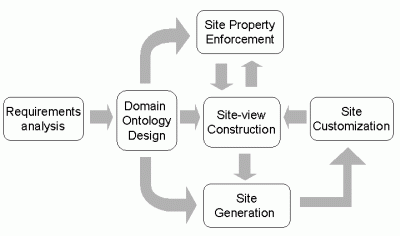
Web Site Management Process
The following a diagram depicting the Web site management process.

We distinguish two basic roles in the managing of Web sites, the knowledge engineer who manages the content to be presented on the Web site, and the
site engineer who uses OntoWebber to create and maintain the instance Web sites. As is shown in
the diagram, the management process of the OntoWebber system consists of the following stages:
Requirements analysis. The knowledge engineer conducts a detailed analysis of the objectives of the site, data characteristics, user
requirements, etc.. These aspects are the foundation for the rest of the processes.
Domain ontology design. After analyzing the data, the knowledge engineer extracts the necessary concepts with their properties and
relationships, and creates the domain ontology. The domain ontology serves as the basis for the content presented on the instance Web sites to be
created.
Site-view Construction. The site engineer uses OntoWebber to create a graphical representation of the instance Web site. OntoWebber
translates the graph into a set of distinct site models representing
different aspects of the instance Web site.
Site Property Enforcement. During either site development or maintenance period, the site engineer can use OntoWebber to enforce
properties on the instance Web site by defining and verifying integrity constraints against specific models and ontologies. The result of the
verification could cause the revision of site models or even the domain ontology.
Site Generation. To generate the instance Web site, OntoWebber reads the site models, queries the source data, and generate
static or dynamic Web pages according to the model specification.
Site Customization. The site engineer can customize all aspects of the instance Web site through modifying the corresponding graph and
regenerating the site in OntoWebber. The presentation aspect of the site can also be customized online by site viewers when interacting with the
site.